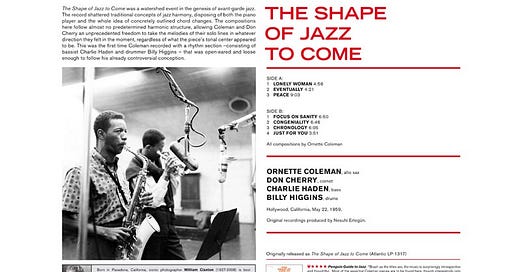This poem is the “closer” from my recent—and third—collection Kinds of Blue (more about that project, below), and it explores the exact moment that a burgeoning interest became an obsession that would profoundly alter my life, for the better. Certainly, it celebrates jazz music and my love affair with this form of expression, but it’s also nostalgic in, I hope, all the right ways in that it evokes that indescribably special time of life some of us are fortunate to have, where we’re exposed to all sorts of influences (cultural, political, artistic, etc.) and, if we’re lucky or smart enough to be sufficiently humble and curious, incorporating new ways of thinking and feeling into our still-unformed minds and souls.
It’s easy for me to discern, now, that these were formative years in ways that still impact my day-to-day life and the sensibility I’m still shaping, but I was keenly aware, then, that something way below the surface, a force both actual and spiritual, was speaking to me, and I had a choice: listen, and follow, or turn away in fear. I let my ears guide me, and began to understand that the ears lead to the heart, which pumps blood into the guts, and it’s by heeding this historical impulse that things change forever, one moment or interaction or song at a time.
The Shape of Jazz To Come
I still remember everything about it. Fall semester, senior year. The more I learned at college, the more I understood how little I knew. Something, obviously, was working. I was prescient, or just plain lucky enough to sign up for an elective called “Introduction to Jazz.” We’d gone through the century, decade by decade, and it got better as we went. Yes, Bebop was what I’d been missing all along without realizing it. But it was what came next, the more formless expression that started creeping out of the margins—like lava oozing through ancient stones—that portended obsession. Those names: Mingus, Monk, Miles. And then, as we tackled the topic of “free jazz,” a dissident with the audacity to name an album The Shape of Jazz to Come: Ornette Coleman, the canary in the post-bop coal mine. Like all iconoclasts, initially greeted with indifference, then disgust, then fear. His compositions scoffed at convention, freak flags flying out of the underground into the avant-garde. I still remember how quiet the room was and how concerned my ears got: What is this? Like something I’d never heard or felt; a new language, a new sensation, a new way of seeing everything, that first amoeba slithering onto shore, nothing I’d ever known and all the things I now knew I needed. How is it possible, I thought, to make instruments scream in agony and shriek in joy, at the same time? I walked around campus after, the autumn sky all schizophrenic yet serene with colors. And those notes I couldn’t get out of my head. This is it, I thought. This is music. This is addiction. This is love. This is the first day of the rest of my life.
About The Book
Kinds of Blue is the third installment of a large and ongoing project that explores America and its mythology through a series of poems that function as biography, history, and cultural commentary. This collection, like the others before it, honors a number of icons (some well-known; others unfairly neglected), seeking to capture something essential about their lives and the times they lived in, bearing witness while paying homage.
Kinds of Blue carves out a designated space to celebrate black artistry, tracing an at times uneasy but undeniable line stretching from field hollers and the blues, to jazz, funk and beyond. Tributes to misunderstood or mistreated icons include musicians such as Thelonious Monk and Marvin Gaye, fighters like Joe Frazier and Marvin Hagler, and comedians like Richard Pryor and John Belushi. Despite every systemic disadvantage and all the obstacles placed in their paths, these geniuses—and others featured in this book—lived, played, persevered, and became immortal. America is still very much a work in progress, but any country that can claim such inspired forces of nature is worth preserving and celebrating.
“Late in Kinds of Blue, his third poetry book, Sean Murphy asks: What is this? How is it possible to make instruments scream in agony and shriek in joy, at the same time? Yet, these powerful poems do just that with lines crafted from the alchemical tip of his historical pen. Conjuring legendary artists such as Miles Davis and Sam Cooke, as well as lesser-known geniuses, Eric Dolphy and Linton Kwesi Johnson, this collection offers the reader necessary pages from our troubled past so [we] might bear witness to an anguished joyful noise that could save and restore. Dear Reader, this book is full of poems you will want to research and then read out loud again, while you trust that hearing is believing. As poetry continually reminds us, we need our collective notes to more fully understand ourselves, our country, our predecessors, in all the potent ways. Even still they sang—coded texts for torn out tongues, the savage air aglow with conviction. I’ve read these poems again and again, then pulled my old albums out; here where poetry and music become one.”
— Susan Rich, Author of Blue Atlas






